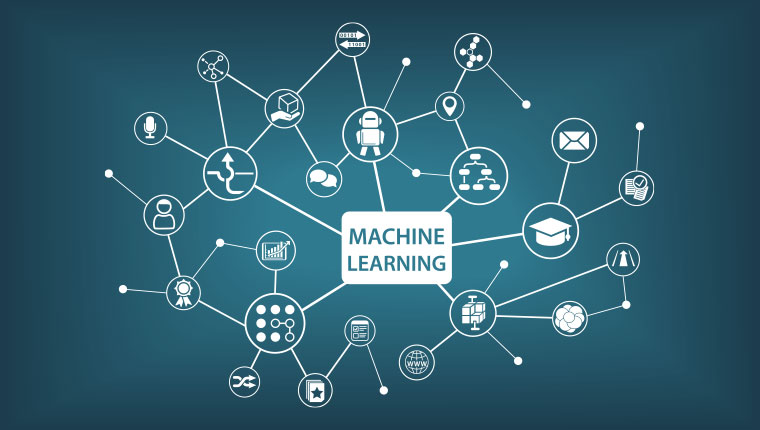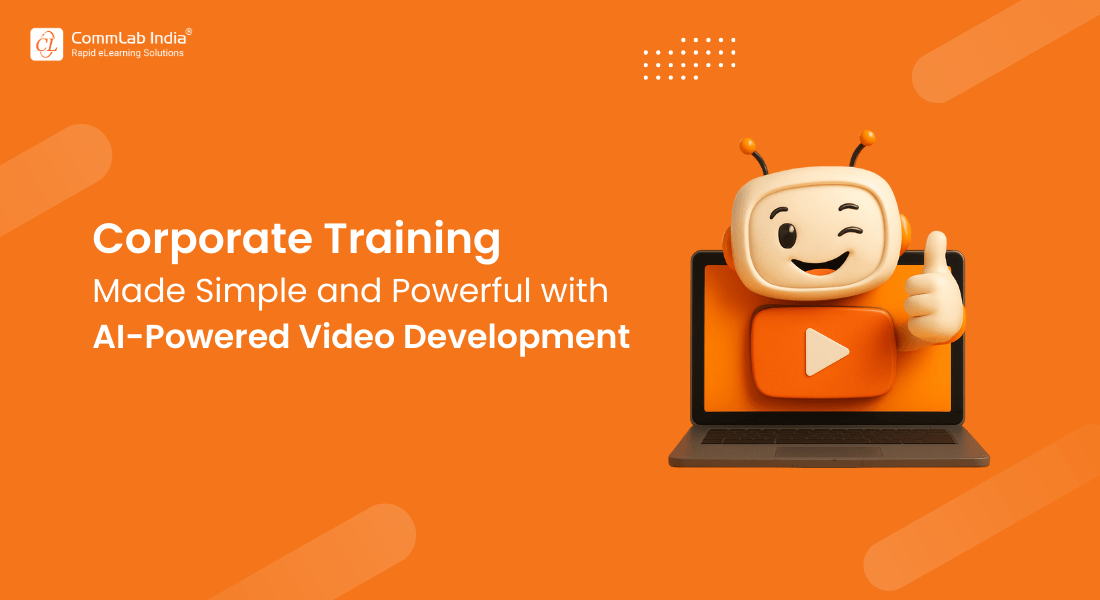A Simple Guide to Understand AI and Machine Learning
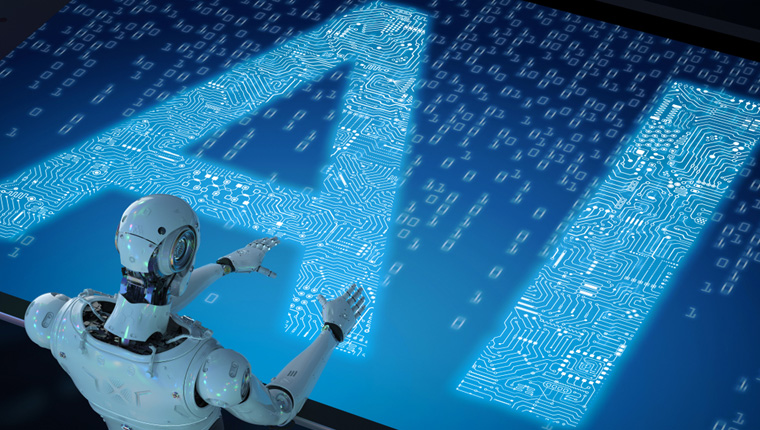
Welcome to the club if you don’t understand the differences between Artificial Intelligence (AI) and Machine learning. Well, it’s hardly surprising since these terms are often used interchangeably. However, they are definitely not the same! And in case you’re contemplating whether these technologies have big implications for the future and on corporate training, here’s news for you!
A Simple Guide to Understand the Differences Between AI and Machine Learning
AI focuses on creating intelligent systems that emulate human intelligence. Machine learning (ML) offers systems the ability to learn on its own from the data provided.
Benefits of AI and Machine learning in Online Training
- Offer personalized learning
- Optimize course content and delivery
- Provide round the clock support
According to a recent survey by Gartner, the number of organizations implementing AI in some form increased by 270% in the last four years and tripled in the last year. So, the fact is: these technologies are here to stay! And if you are unable to parse the difference between AI and machine learning, help is here! This blog can help you understand the differences between AI and machine learning. So, shall we get started?
Getting the Basics of Artificial Intelligence and Machine Learning Right
Definition of AI and Machine Learning
The term “artificial intelligence” was introduced by John McCarthy in 1956. Evidently, artificial intelligence consists of two words: “Artificial” and “Intelligence”. While artificial refers to something human-made, intelligence refers to the ability to think. It is a common misconception that artificial intelligence is a system. It’s implemented in a system. Simply put, you can interpret AI as incorporating capabilities in machines that emulate what human intelligence can do.
Machine learning is a subset of AI that enable machines to learn on their own. To put it simply, machine learning is a way to achieve artificial intelligence. It involves feeding a lot of data to the algorithm that helps the system compute accurate results. In other words, the system need not be explicitly programmed and can make decisions on its own from the data.
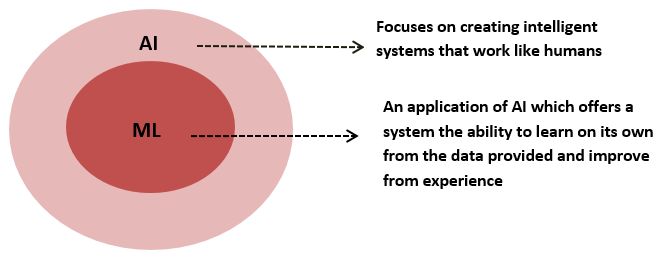
Examples of AI And ML
Here are some of the most popular examples of AI in use today:
- Alexa: A virtual assistant introduced by Amazon. Its ability to decipher speech that help scour the web for information, set alarms, play music, lodge events in calendar, and many other things has popularized the concept of the ‘smart’ home.
- Tesla: An American automotive company that makes cars based on “predictive capabilities, self-driving features, and sheer technological coolness.” (Forbes).
- Netflix: An American media-services provider, Netflix offers highly accurate predictions based on viewers’ past experiences. It analyzes several records to suggest films viewers might like, depending on their past experiences in Netflix.
Here is an example of machine learning to understand it better. Let’s consider this table which identifies fruits based on their characteristics:
| Weight (in grams) | Texture | Fruit |
| 95 | Smooth | Banana |
| 70 | Smooth | Banana |
| 110 | Rough | Orange |
| 145 | Rough | Orange |
| 132 | Rough | ? |
In the table, fruits are categorized based on their weight and texture. So, if the machine learning algorithm is fed with data on the texture and weight of a banana and an orange, it can accurately predict the type of fruit.
Different Sections of AI and Machine Learning
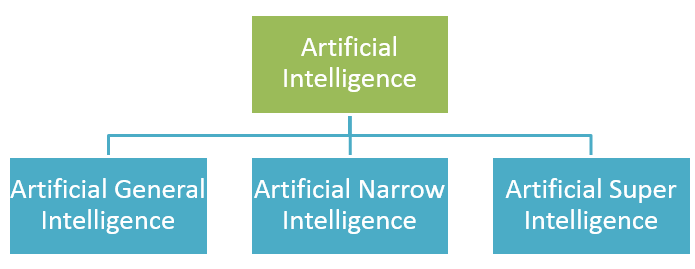
General AI: Holds the ability to exhibit any intellectual task that humans can. For instance, have you noticed the AI in sci-fi movies such as “Her”? You will find humans interacting with the machine and operating systems that are conscious and driven by emotions.
Narrow AI: Only focuses on performing one specific task, hence the name. For instance, playing chess, forecasting weather, suggesting purchases.
Super AI: Oxford scholar and AI expert, Nick Bostrom defines Artificial super intelligence as: “any intellect that greatly exceeds the cognitive performance of humans in virtually all domains of interest” (Medium). Hence, when AI surpasses anything that humans can do — including wisdom, problem-solving, and much more — it will be super AI.
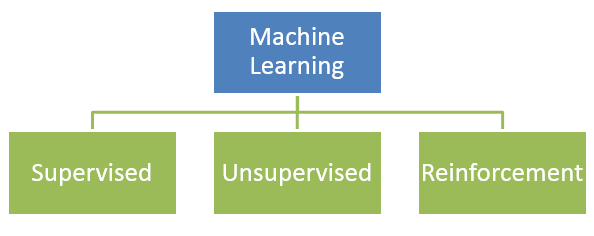 Supervised: This type of machine learning can be assumed as learning under the guidance of a mentor. The dataset can be considered the teacher; its function being to train the machine. Once the machine gets trained, it starts making predictions when new data is fed into it.
Supervised: This type of machine learning can be assumed as learning under the guidance of a mentor. The dataset can be considered the teacher; its function being to train the machine. Once the machine gets trained, it starts making predictions when new data is fed into it.
Unsupervised: Unlike supervised, an unsupervised machine learning system learns through experience and tries to find structure in the data on its own. Hence, the machine automatically finds relationships and patterns when a dataset is provided to it.
Reinforcement: In this, the machine tries to train itself using “trial and hit”. Simply put, the machine learns from its past experiences and tries to predict the best possible solution to a problem.
Benefits of Artificial Intelligence and Machine Learning in Online Training
Offer Personalized Learning
AI technologies predict accurate results using algorithms which help in providing relevant eLearning content by analyzing learners’ past experiences and goals. For instance, your learners preferred courses which had more of kinesthetic activities. The AI-enabled Learning Management System (LMS) will adjust the learning course automatically to include activities such as game-based nuggets or simulations.
Similarly, if a learner is struggling with a certain topic in a course, the system will recommend resources that cater to that exact learning need.
Optimize Course Content and Delivery
There are two benefits here. First, your learners are offered exactly what will help them fill their learning gaps and achieve their goals. This implies training will be more rapid, since learning is tailored to what learners require instead of attending generic training sessions.
This is directly linked to the second benefit. Instead of spending more time on analyzing data and metrics, your L&D team can focus on creating effective eLearning courses. This is because the Al-enabled LMSs takes care of evaluating data and delivering relevant content to your learners.
Provide Round-the-Clock Support
A cloud-based LMS with integrated AI capabilities can act as a mentor who offers round-the clock support to your learners. This is possible when you offer the system a knowledge base to learn from. The LMS will then suggest learning resources or solutions on its own. It’s much like a virtual assistant that resolves your learners’ queries right when they need.
Challenges to AI and Machine Learning
A lot has been said about the challenges associated with AI technologies. Some of which are: :
- Lack of social interactions
- Over-reliance on technology for solutions
- Chances of data loss
The most prominent one is the heavy cost associated with incorporating AI technologies in online training. Apart from the cost of installation, a considerable cost will be incurred on maintenance, repair, training employees on managing these technologies, leveraging them, and so forth. Hence, your organization will have to drastically increase its training budget to support AI technologies in online training.
Tying it Together
Here’s a table to quickly recap the differences between AI and machine learning:
| Artificial Intelligence | Machine Learning |
| Training machines or systems to perform intellectual functions that humans can do | A subset of AI, which offers machines the ability to learn from the data provided and predict accurate decisions on its own |
| Involves decision making | Letting systems learn new things from data |
| The goal: Simulating natural intelligence to resolve complex problems | The goal: Learning from data on a specific task and enhancing the performance of the machine on that task |
While AI and Machine Learning being the trending topics, we have more for you to consider in online training. Here’s a free eBook on “eLearning Trends 2020” for you to download. This handy guide will give you our insights on 20+ trends that will make it big!



